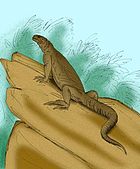Pariguana
Appearance
| Pariguana Temporal range: Late Cretaceous,
| |
|---|---|
| Scientific classification | |
| Domain: | Eukaryota |
| Kingdom: | Animalia |
| Phylum: | Chordata |
| Class: | Reptilia |
| Order: | Squamata |
| Clade: | Iguanomorpha |
| Genus: | †Pariguana Longrich et al., 2012 |
| Type species | |
| †Pariguana lancensis Longrich et al., 2012
| |
Pariguana (meaning "near Iguana" in Greek) is an extinct genus of iguanid lizard from the Late Cretaceous of western North America. It is known from a single type species, Pariguana lancensis, named in 2012 on the basis of a partial lower jaw from the Lance Formation in eastern Wyoming. This jaw bone comes from a layer dated approximately 650,000 years before the Cretaceous–Paleogene extinction event. Pariguana is the oldest definitive iguanid from North America, and may represent the first stage of the iguanian evolutionary radiation from Asia into North America.[1]
References
- ^ Longrich, Nicholas R.; Bhullar, Bhart-Anjan S.; Gauthier, Jacques A. (2012). "Mass extinction of lizards and snakes at the Cretaceous–Paleogene boundary". Proceedings of the National Academy of Sciences of the United States of America. 109 (52): 21396–401. doi:10.1073/pnas.1211526110. PMC 3535637. PMID 23236177. Retrieved December 11, 2012.





